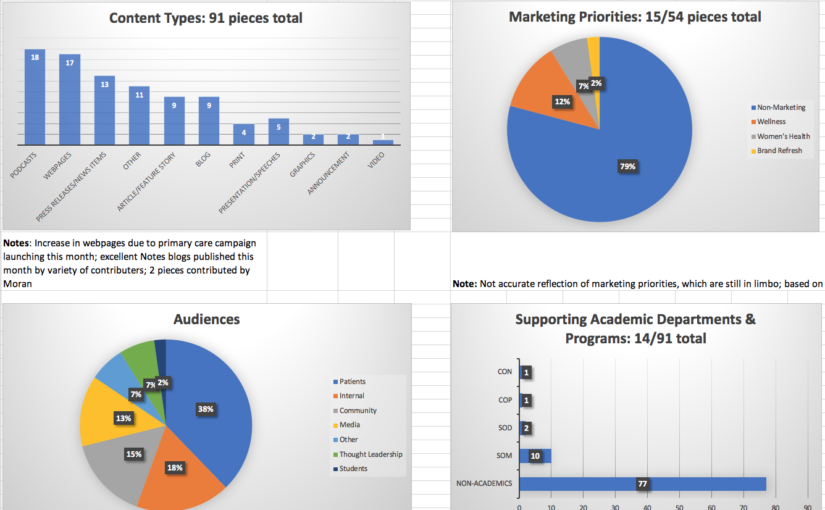No Content Strategy? Try These 3 Things to Start Moving in the Right Direction.
Raise your hand if you have no content strategy.
Raise your hand if you have a partial content strategy (in the clouds around your head, somewhere…).
Raise your hand if you are a genius. All of your hands should now be in the air, ‘cause you can point your organization in the right direction towards a content strategy by starting with these small steps (and always claim to be a genius—humble brag my people).
Recently at work, in tandem with multiple fortuitous circumstances, I was able to assist in setting up some editorial management for content. It’s just a start, mind you, and rather opposite of the “ideal” methodology (business goals –> content strategy –> editorial calendar –> content creation and maintenance, #amIright?). But if you, like us, need to work with priorities that change on the fly, demanding clients no matter the validity of their requests, and a multitude of contributing teams, you might try some of these first steps we have taken.
1. Compile Task/Work Lists
Ideally every piece of content would roll up to a top-level strategy. But sometimes it’s necessary just to gain that measurement of the current state. This can be difficult, however, without a spreadsheet or task management system of some kind. In our office over the last two years, we have slowly consolidated into one main project management system, Asana.
Everyone enters their projects differently and even uses different tracking methods (my team uses complexity scores; another team relies more on time logs; yet other teams rely on output). The one thing we all do, however, is enter our content-to-be-done into Asana as tasks. Knowing that the majority of our teams enter the majority of their content as tasks into the system (or spreadsheets, which can be imported into Asana), I thought I’d take a stab at organizing it all into an editorial calendar.
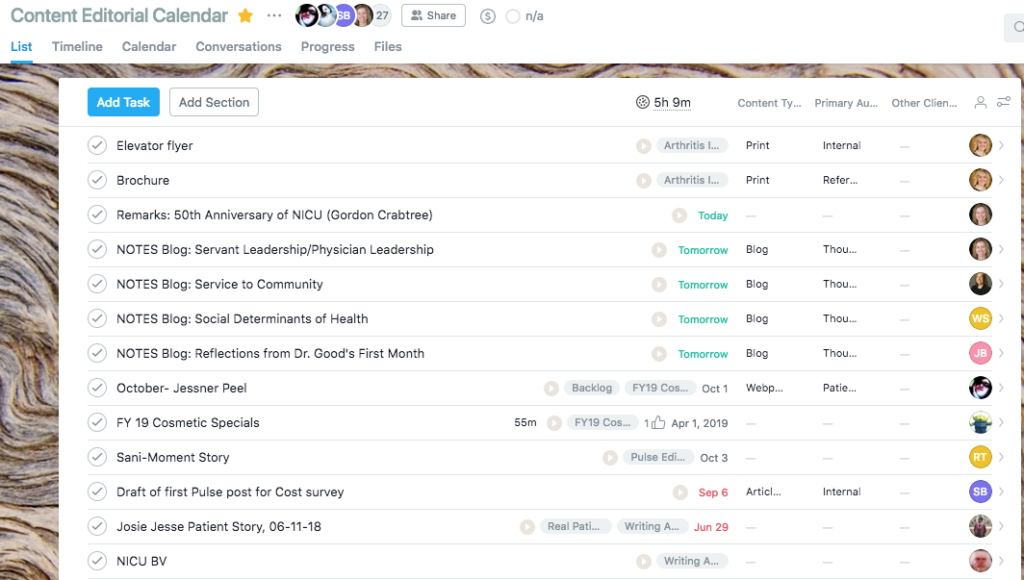
In Asana, this meant setting up a project and literally just tagging each content task as part of the project (1 hour – that’s all it took).
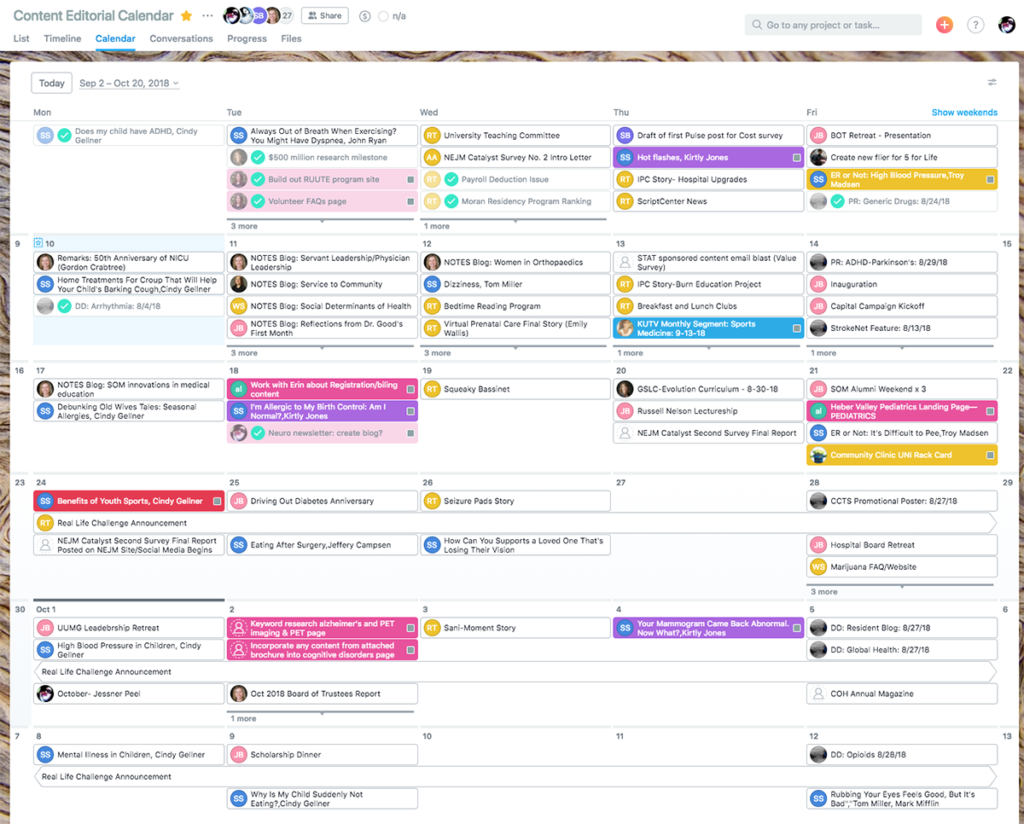
You Don’t Have a Project Management System (& Heads Will Roll Before You Get One)
You don’t need a project management system to make a list, however. The good, old-fashioned spreadsheet will do just as well. It’s true that you probably can’t rely on all your content creators entering things into a spreadsheet, and that might not change, but change for good sometimes rests on the shoulders of you—the superhero in plainclothes.
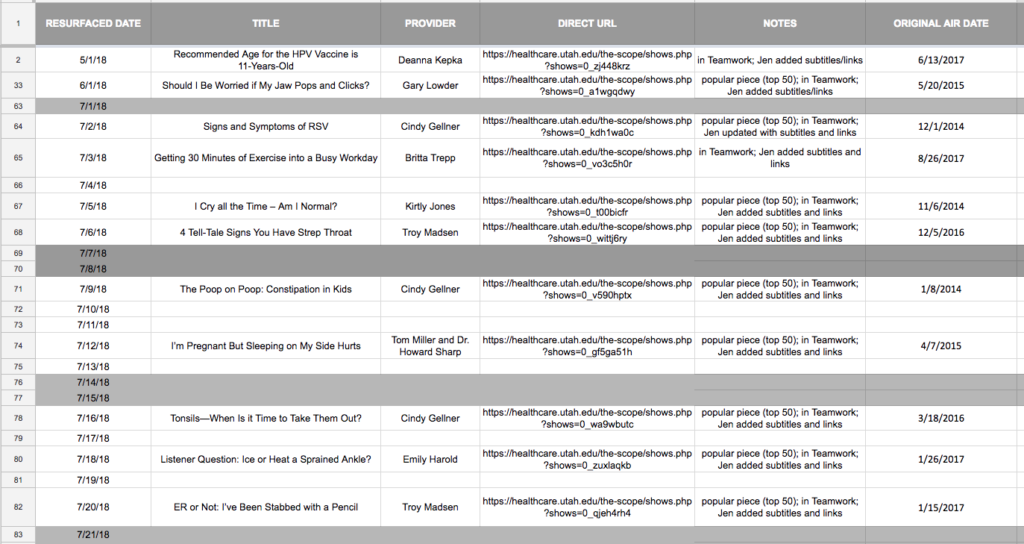
Writing things down holds people (yourself included) accountable. It’s something to measure. Lists are the best friend of measurement and tracking; they are data points in and of themselves. They are also the easiest place to start.
Generally, people just need a rallying point. It’s not that they don’t want glory, lauds, and honor, it’s just that they don’t know how to go about it. All it takes is that one person starting the process.
2. Assign Categories—Thereby Setting Up an Easy, Quantifiable Way to Show the Output You Are Creating
One thing I would add to your soon-to-be-editorial calendar is categories (tags/columns—whatever). Why? These categories will help you see what track your content is on. Who’s your audience? What type of content is being created? Categories will section your content and add that special razzle dazzle to a spreadsheet or list.
On our editorial calendar (notice it’s not a list anymore—IT’S A CALENDAR), we use these categories:
- Audience
- Content Type
- Marketing Priority (if aligns with specific)
- Service/Topic
This gives you an immediate view of what’s been done and where the majority of your time and budget commitment is going. While it doesn’t equate with the complexity of creation or the time spent on it, this data is still an easy, quantifiable way to show the output you are creating.
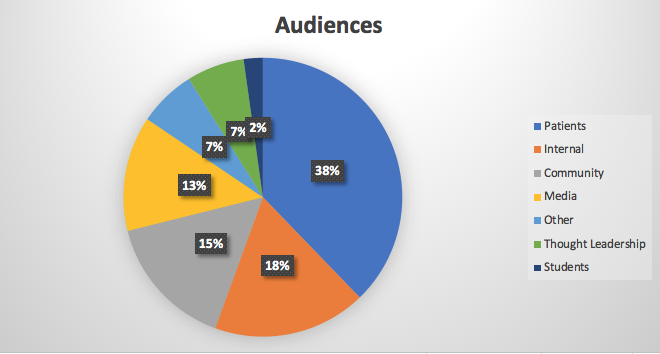
Once again, organizing by category will tell you if what you are creating is directed at the audience you are trying to reach. You are using your list as data points, in this case to tell a story about your current state.
For example, in Figure 3 you can see we are creating content for all the inhabitants of Noah’s Ark a lot of people. While the content is pretty evenly divided along what the organization prioritizes, this graph brings up interesting questions. Should we be spending so much of our creative power on content for patients? What are we asking those patients to do when they come to our content? (More embarrassingly, do we have calls to action on our content for that particular audience?)
For some people, understanding what’s happening right now helps them to focus on where they need to go. Plus, people really like graphs and charts. Trust me on that one.
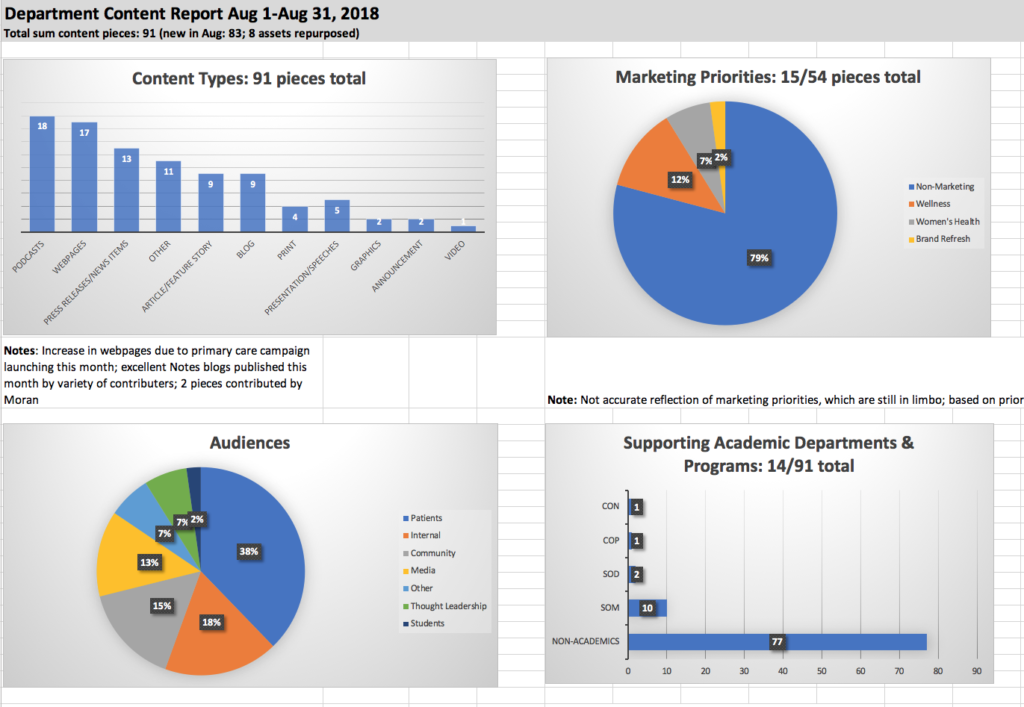
3. Communicate the Work That’s Been Done
Once you have compiled your list of what content has been published in the past week, month, quarter, I recommend posting it somewhere. You could:
- post the list on an internal intranet/blog.
- email the list to your department at large.
- email the list to your boss.
- email the list to other important stakeholders.
Anywhere you can communicate the work that’s been done is good. People want to be recognized and included, particularly if upstairs is impressed by your organizational and list-gathering capabilities. You might even get people to commit to—wait for it—deadlines…
Action, Information, Reaction: Feedback Loops Can Lead to Change!
What you have just done in compiling this list and emailing it out is create a feedback loop. You have taken what everyone mostly already knows and just made it available real-time. While some would write this off as so easy – then why haven’t they done it yet?* Research has shown that feedback loops help us change:
“Provide people with information about their actions in real time (or something close to it), then give them an opportunity to change those actions, pushing them toward better behaviors. Action, information, reaction.” —Thomas Goetz, Wired Magazine
By compiling this list, you are helping people see some organization in their work. You are showing people what was accomplished in a certain period of time and how that could possibly influence the future. You are helping people engage in—eek!—thinking about cause and effect, value, return on investment.
Those Fragile Toes We Stepped On—Change Is Hard
As change does, this will step on some toes. Even if you try to communicate when, where, why, and how what you are doing is a force for good, someone out there will claim that they never knew about it and why didn’t you tell them?^
This work-culture attitude, that change is hard, takes work. However, few things are more motivating in favor of change than these things:
- Inclusion
- Competition
- Appearance
- Demonstration of advantages
When faced with someone who hates what I’ve done, the only thing I can say is this: Sorry to tread on your toes. Please give me your feedback. I would love to involve you as your work is an important part of our content initiative.
Is it Flattery or Genuine Appreciation?
Occasionally I mention to people that I treat all my clients like they are unique and special. This includes co-workers, collaborators, and upper management. Some would call that cynical and manipulative. The difference is that I actually (99.99% of the time) mean it!
There is something to appreciate in everyone. If you can find it, you will succeed. That doesn’t mean sidestepping accountability, but appreciating what your co-workers accomplish.
Benefits of Measuring Your Current State –> The Editorial Calendar
Some may say that if you don’t have a strategy, why bother with an editorial calendar? It’s true that an editorial calendar does not replace a content strategy; however, sometimes it’s enough to start with what you have and make incremental changes in the direction you would like to go. Even little changes can lead to great waves.**
The benefits of gathering this information and putting it in one place are these:
- Help instill a feeling of unity between content creators (technically, you are working towards the same goal).
- Foster collaboration.
- Gain a true appreciation of just how much work others are doing.
- Communicate that you care about the content being produced.
- Nudge content creators towards thinking in terms of audience-based content.
This is a simple (but often boundary pushing^^) step in the right direction. Sometimes it’s a gargantuan effort, particularly if you are working with people who don’t play well together, but often the initial act of compilation can push your team/s towards seeing the current state of things. On the path to Valhalla, we heroes must create the path. After all, nobody starts out a hero. It’s the journey that truly defines you. (See Harry Potter and the Deathly Hallows, 2007, Bloomsbury Publishing.)
P.S. You also don’t have to tell them that next up, you are going to start examining vanity metrics more closely for patterns and that you are going to point out holes in your current content assets and maybe challenges in the creation process. World domination takes time my friends.
*This is a defining concept of modern art. Just think—we could all be smearing ketchup on weird glass blocks and have a show at the Centre Pompidou in Paris. But we didn’t. So we can’t.
^Quite frankly, I don’t blame them. Stress at work can lead to hair trigger tempers when it comes to change. Not that I have ever gotten upset like that…
**Sometimes only clichés can accurately capture your truth. Is that lazy writing though? A question for another day.
^^Hello paradox, my old friend. Why is it so hard sometimes to take one step forward?
